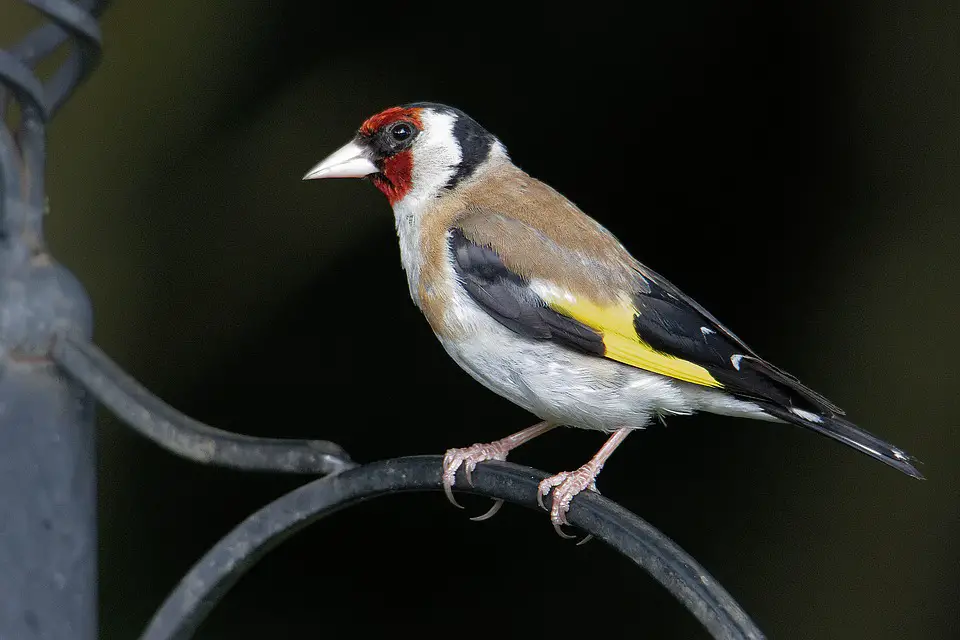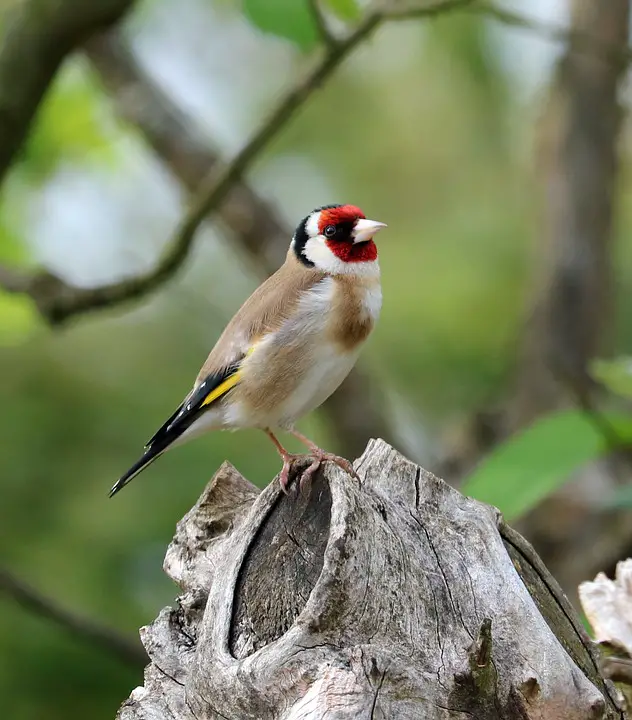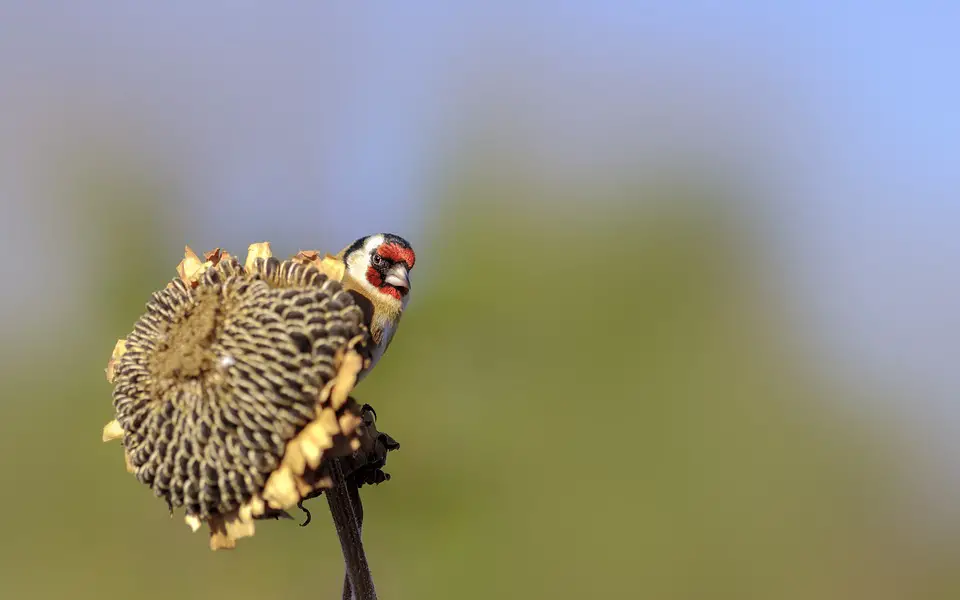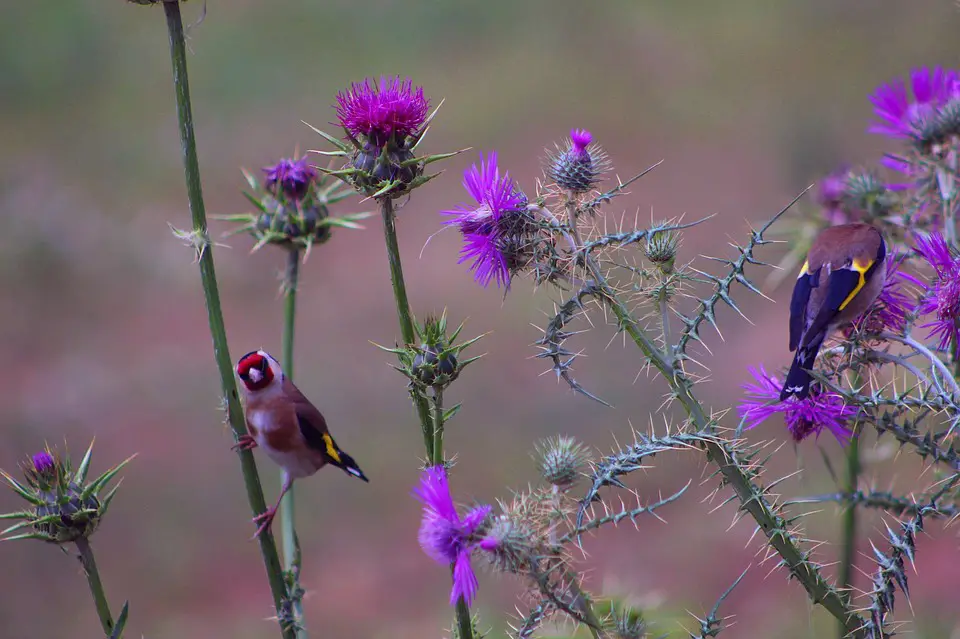Have you ever stopped and actually taken notice of the different types of birds that visit your garden or do you simply enjoy all varieties of songbirds and dutifully replenish the empty feeders when necessary?
Starlings, blackbirds and sparrows are very common in our gardens, along with the bigger ‘bully boy’ birds, the wood pigeon, collared doves and magpies.

Blue tits and other members of the family may frequent your feeders, along with the occasional chaffinch. This brought his beautiful cousin, the goldfinch, to mind, is it possible to attract him into our gardens and make him want to return?
Table of Contents
How to attract Goldfinches
As with all garden birds, the most obvious way to attract them is with food. A good variety of their favourite things to eat will undoubtedly catch their attention.
Thistles and teasels are superb forms of nutrition for him, as are the seeds of smaller plants such as dandelions and groundsel.
High hanging bird feeders filled with niger seeds and sunflower hearts are his preference too.
As he is such a shy little fellow, he will appreciate somewhere to rest and wait his turn at the bird table, maybe in the branches of a nearby tall tree. He prefers to both nest and eat at height for reasons of security.
Consider hanging a nesting box with a very small entrance very high in a tree in your garden. Although they are expert nest builder’s they occasionally take advantage of a ready assembled home too!
Tall climbing plants with bright and nutritious berries will also appeal to him, bugs found between the leaves offer a change to his mostly vegetarian diet, and the dense greenery offers a place of safety.
Why do we want to attract the goldfinch?
That is very simple to answer. We want the goldfinch in our gardens because they look stunning and sound spectacular.
The breeding male has a very recognisable red face on a black and white head and a broad yellow bar on his black wings.
Their song is fluid and tuneful, so appealing to the earas they peacefully chatter away.

The Menu
Many goldfinches migrate in winter; Spain, France and Belgium are their usual destinations. Although not all do, so it is still worth stocking feeders during the colder months too, with their preferred foods.
Niger seeds
The absolute go to choice if you want to attract goldfinches to your garden, a little more expensive than other birdseed mixes, but the results far outweigh the extra cost.
Tiny black seeds that pack a punch, they are high in protein and full of good fats, essential for the winter as they provide energy and warmth.
The high calcium levels are also ideal for keeping his bones and beak strong.

Sunflower hearts
The inside of a sunflower seed after it has had the hard outer shell peeled away. They are small, soft and white. They are very compact and easy to carry so prove a perfect food for his young. He will regurgitate then and drop them into the nestling’s open mouths, very easily digestible.
These have similar properties to the niger seed, the fact that they are so nutritional means he just has to eat a few to gain high impact.
Both the sunflower and niger seeds should be placed in their own designated feeder, a mesh one with tiny holes is perfect as it will deter other larger birds from using it while the goldfinch can use his perfectly evolved, long sharp beak to prise the seeds through the holes.
Freshness is key
Keep seeds fresh as he is a particularly finicky eater, he will bypass them should they become stale. Do not let them get damp either, this will attract bacteria and can make the bird very ill.
Hang your feeders high, above head height at least, from the branches of a tree. This is to prevent him from feeling intimidation from predators.
Be patient when hanging new feeders, it can take up to two weeks for the goldfinch to notice! Trying tying something bright to the top of them, a short length of bright yellow ribbon is ideal for catching his attention.
If your feeders are to be hung from a bird station, try and provide somewhere for the finch to wait his turn, he will do as he’s patient, so lots of arms on your table are perfect, or even better, place the station close to a tree.
Remember, they fly in flocks of up to forty birds, so it would be an absolute treat to see them all patiently sat queuing for lunch in your apple tree!

Appetisers
Teasels. If you don’t have any in your garden then you should get planting now. In summer, the purple flower attracts insects, bees, butterflies and moths, but during the autumn and winter, the teasel comes into its own.
The tall plant becomes brown and prickly and the seed heads dry out. The goldfinch adores the contents of the pod and his perfectly designed beak makes light of emptying the seeds. He uses his long and pointed bill in a tweezer like method, scissoring the seeds from their casing.
Dandelions and groundsel
Not only are thesefantastic for attracting bees and butterflies but the seeds supply a great source of food for the goldfinch. He is light and agile enough to land on the stalk, just causing it to bow a little, and use his beak to pluck the seed from its base.
I thought dandelions were only good for telling the time!
Understandably, gardeners are not inclined to have a lawn filled with dandelions, but maybe a wild patch set aside would be a perfect feeding ground for the goldfinch. Load it with lavender and thistles too, the seeds of which are tasty and nutritious and the bright colours will attract a plethora of insects and bugs.
I hope that you will achieve great success if you try some of these methods; goldfinches hanging acrobatically upside down from a niger seed feeder, is definitely a feast for any keen bird-watchers eyes.

Really useful advice and tips here thank you.
Thanks for the helpful advice, Walter! I’m a doctor based in the West Midlands and am really enjoying watching and taking photos of the various birds visiting my garden. Fingers crossed for some goldfinches!
Whilst undoubtedly a beautiful bird, we find that the goldfinches absolutely hog the feeder, sadly to the exclusion of all other birds. They are quite aggressive and very messy feeders, often squabbling amongst themselves for priority – perfectly normal I guess!
We have a small garden with just one feeder, and feed sunflower hearts exclusively, typically getting four or five birds at a time. They will sit on the feeder’s perches, often looking around and chomping on the seed with their scissor-like beak action, such that a good proportion flies out out of their beak and ends up on the ground in a radius of about 18″, which precludes the use of a tray beneath the feeder. With gravel and soil around the feeder, it soon becomes a real mess. It is not feasible to move the feeder or place a flat solid surface to cover the affected area.
We used to put up Niger seed as well, but the goldfinches were just not interested at all!
Previously we hung the feeder in front of a hedge at the bottom of the garden, and got loads of different birds for us to delight in – bullfinches, blackcap as well as the usual tits etc, but we soon found squirrels and rats were also encouraged, and caused damage as well as keeping other birds away. After unsuccessfully trying various cages around the feeder, we moved the whole thing about 7 feet away from the hedge, so it is now not surrounded by vegetation at all. At least that solved the problem of the unwanted visitors, but still we don’t now seem to get other birds, even when the gold finches are away. In fairness though, having said that I don’t spend all my time watching! But it is such a contrast from previous experience when it was near the hedge.
So, apart from adding another feeder, which I fear may still get ‘hogged’, can anyone suggest other ideas to attract the other birds, please? Any suggestions re- scattered food would also be welcome.
PS Apologies for this long post, but if you feel it irrelevant for your website, I’ll understand!
Thanks.